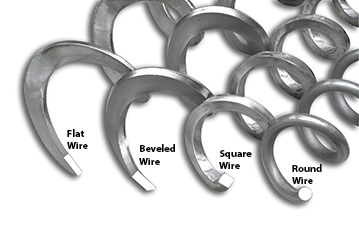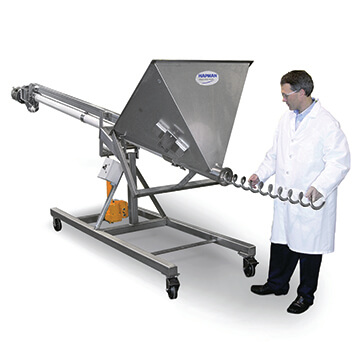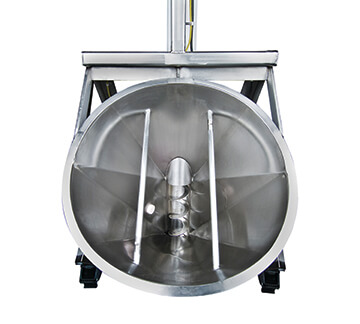Increasing Conveyor Performance and Efficiency
Due to their relatively low cost and simple construction, flexible screw conveyors are one of the most common types of conveyors used by manufacturers. The reason for this is that the screw is the only part of the conveyor that moves. The only other major components are the tubular housing, and the electric motor that drives the screw (also called the auger).
Despite its uncomplicated, yet reliable construction and straightforward operation, many end-users overlook important factors that could potentially lead to poor performance, excessive power usage, severe wear, and material degradation. For these reasons, it is essential to consider all system parameters when selecting conveyor options. Only then can you ensure a correct and successful installation that achieves maximum operational efficiency.
Specifications
The flexible screw conveyor has a helicoid screw that rotates inside a fixed tube. Screw conveyors typically range in diameter from 2 1/2 to 8 inches, and can be used for horizontal transports of up to 80 feet, and inclines of up to 60 degrees. An 8 inch diameter screw conveyor can transport 1,800 cubic feet/hour at 360 RPM at a 45 degree angle. The flexible screw is made from stainless steel, and is available in round, flat, square bar, and beveled edge configurations. As the screw rotates, it creates directional force that moves the product through the tube. At the same time, it also creates centrifugal force that moves the material against the wall of the tube.
Material Characteristics
The characteristics of the material being conveyed is an extremely important element to consider when selecting any conveyor. Flexible screw conveyors can move many types of materials, such as powders, crystals, flakes, granules, pellets and irregular shapes. But even then, you need to consider how the material will affect the conveyor, as well as how the conveyor might affect the material. For example, certain materials – such as TiO2 or salt – have the potential to create friction within the flexible screw conveyor. This can cause some particles to be crushed, heated, or chipped during transport. In addition to having a negative effect on the product itself, material friction can cause the conveyor’s motor to be overtaxed, increasing wear and eventually leading to failure if left unchecked. Or, the actual material being conveyed could build up on the screw and cause it to stall.
Flexible Screw/Auger Types and Characteristics
There are many auger designs to choose from, each addressing the challenges presented by different material characteristics. To get the best results possible from your flexible screw conveyor, select the auger type that best suits the material you need to convey.
 Flat Wire
Flat Wire
Flat wire augers are used for conveying powders or other light materials, and are made of rectangular or square wire. The flat conveying surface wire. The flat conveying surface applies a more positive forward directional force on the product being conveyed and reduces the outward force against the tube wall.
Beveled or Square Bar
This type of auger is specifically designed to convey difficult-to-handle or fragile material with minimal product degradation or damage. The beveled auger must be installed straight. It maintains a much lower maximum allowable RPM level, and operates at a maximum of 600 RPM.
Round Wire
These flexible screws are made from a coiled round bar, and are mainly used for heavy or highly abrasive materials. The biggest asset of this auger design is its strength and flexibility, which minimizes the load imposed on it by material weight, particle shape, or material size. The round wire auger design creates high slippage and stronger outward forces on the conveyed product.
Centercore
 This is a small tube placed in the center of the screw and extends the full length of the auger. The centercore restricts the space by reducing the amount of material allowed to enter the conveyor, which in turn reduces the load imposed on the screw. Use a center core when conveying very dense products or highly aerated or fluid product.
This is a small tube placed in the center of the screw and extends the full length of the auger. The centercore restricts the space by reducing the amount of material allowed to enter the conveyor, which in turn reduces the load imposed on the screw. Use a center core when conveying very dense products or highly aerated or fluid product.
Flow Rate
Flow rate can be increased or decreased based on:
- Type of auger used
- The auger’s rotation speed
- Configuration of the feed hopper and tube
- The material’s flowability and overall characteristics
- Conveyor’s angle of incline
A general rule of thumb is to set a flexible screw conveyor at no more than a 45 degree angle. Taking into account the material’s characteristics, you may be able to convey above 45 degrees without risking back flow, or may need to decrease the angle to below 45 degrees to prevent back flow when conveying heavier materials.
Capacity and Power Requirements
Many factors affect capacity and power requirements. The most common elements to consider are material particle size, material bulk density, material flowability, conveyor length, auger rotation speed, conveyor diameter, helicoid pitch, and conveyor incline angle. Optimal operation will depend strongly on the conveyed material, the RPM of the auger, and the filling degree of the system
Analysis of Flexible Screw Conveyor Advantages and Potential Limiting Factors
The Flexible Screw conveyor offers an optimal conveying method for the broadest range of batch processing applications. As with any type of bulk material handling conveyor, there are advantages and limiting factors that should be considered when equipment selection is made. Here are some of the advantages and limiting factors to consider when selecting a flexible screw conveyor:
Advantages
- Well suited for horizontal and vertical conveying
- Easily transports many free-and non-free flowing bulk materials
- Low cost
- Takes up very little floor space
- Easy to clean
- Allows for flexible installations
- Offers low to moderate material degradation
- Ensures a dust-tight system, with hopper options to ensure that product remains within the process
Limiting Factors
- Residual product left in the casing
- Height and length limits (Maximum horizontal transports are limited to 80 feet, and inclines up to 60 degrees)
- Different screws may be required when conveying multiple products with the same conveyor
Incorporating Operational Considerations
 With the exception of initial charging and emptying, flexible screw conveyors should never be run empty for extended periods of time unless they are specifically designed to do so. To allow the conveyor to run without material in the hopper causes excessive fatigue on the system’s components. To mitigate this potential problem, use sensors at the pick-up point to automatically shut off the conveyor when material is not present. Dry operations occur when a conveyor has been running fully loaded, or at a high fill percentage, and is then no longer given material to convey. This typically happens in applications where increased slippage, visual material roll-back and steady decrease in output. A conveyor can be designed to run under these conditions by utilizing the proper outer tube, screws and slower RPM levels.
With the exception of initial charging and emptying, flexible screw conveyors should never be run empty for extended periods of time unless they are specifically designed to do so. To allow the conveyor to run without material in the hopper causes excessive fatigue on the system’s components. To mitigate this potential problem, use sensors at the pick-up point to automatically shut off the conveyor when material is not present. Dry operations occur when a conveyor has been running fully loaded, or at a high fill percentage, and is then no longer given material to convey. This typically happens in applications where increased slippage, visual material roll-back and steady decrease in output. A conveyor can be designed to run under these conditions by utilizing the proper outer tube, screws and slower RPM levels.
Cleaning
During standard operation, all flexible screw conveyors will leave residual material in the inlet tube once the hopper is empty. This material can be extracted by removing the end clean-out cap at the bottom of the conveyor and reversing the rotation of the screw, allowing for quick evacuation. Further cleaning can be performed with air, water or solvents with or without disassembly of the unit. If more cleaning is required, the outer tube and/or flexible screw can be removed and thoroughly cleaned. Another option that is ideal for applications where total evacuation of conveyed materials is critical, is employing a Hi/Lo or tilt-style flexible screw conveyor. The Hi/Lo allows the operator to lower the conveyor to a horizontal position and fully remove the screw. Wash-downs, clean-outs, auger changeovers and regular maintenance are all greatly simplified with improved results. Another benefit of using the Hi/Lo option is that operators can clean and disassemble the conveyor safely on the floor in just minutes without the use of lifts or ladders.
Modes of Operation
Batch Operation
 This is the easiest of all duties. When only one material is batched, it is relatively easy to maximize batch output so that residual product is left in the conveyor to maximize its repeatability. The residual product remains should be considered, since it may contain various ingredients which may not completely transfer from the system as desired. By first introducing a portion of the larger, major ingredients, followed by the smaller, minor ingredients, and then dumping in the remaining portion of the initial major ingredient, you can minimize loss. This is just one method of batching when exact weighment is not critical.
This is the easiest of all duties. When only one material is batched, it is relatively easy to maximize batch output so that residual product is left in the conveyor to maximize its repeatability. The residual product remains should be considered, since it may contain various ingredients which may not completely transfer from the system as desired. By first introducing a portion of the larger, major ingredients, followed by the smaller, minor ingredients, and then dumping in the remaining portion of the initial major ingredient, you can minimize loss. This is just one method of batching when exact weighment is not critical.
Intermittent Operation
During this process, the conveyor starts and stops in a repetitive fashion under full load. Be aware that some heavy materials may cause start-up issues. To mitigate this problem, special modifications can be made to the conveyor that will add to its structural strength and/or reduce the amount of material during start-up.
Continuous Operations
Flexible screw conveyors that perform non-stop for extended intervals need to be specifically designed for this type of operation and should be sized to run at an average speed range. In addition to operational factors, there are a few other elements that need to be considered. For example, if the conveyor is inclined, tests must be run to determined capacity and power required. It should be noted that capacity decreases as you increase the incline. The power requirement increases with speed at any slope. When calculating the power requirements and capacity limits, keep in mind that the material bulk density, angle of incline, rotational speed, diameter and length of the conveyor will all factor into these requirements.
Summary
Flexible screw conveyors are a cost-effective, dependable choice for conveying a wide range of materials. The rugged, simplistic design keeps maintenance low, provides user-friendly operation, and is engineered for reliable service. An simplistic as they are, several important factors must be considered first to ensure proper operation and optimal service: Material Characteristics – Heavy granules, light powder, abrasive or corrosive, wet and sticky, dry and aerated, etc. Process Criteria – Continuous flow, or batch conveying; steep incline, or long runs. Gathering the application data first can ensure you’re getting the right tool for the right application.
Author Bio
Mike Zeluff has a bachelor’s degree from Michigan’s Grand Valley State University. Mike has worked at Hapman as a Technical Product Manager for 17 years. Mike also worked as a Hapman Regional Sales Manager, and was manager of the Hapman Test Lab where he was responsible for material testing and flow dynamics reporting.
